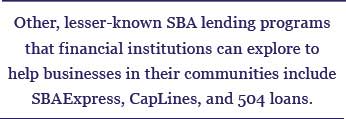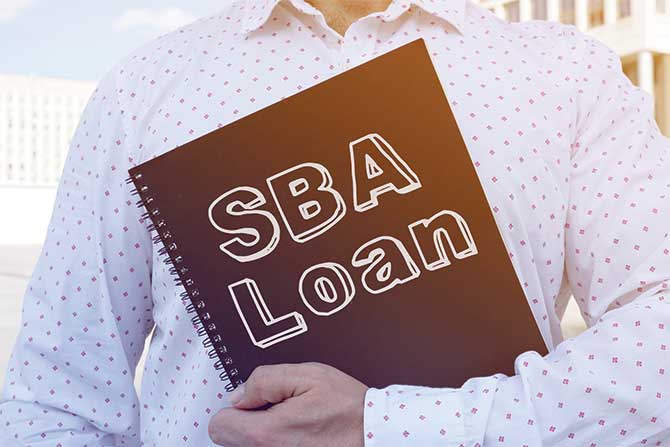By Mary Ellen Biery, Abrigo
For many financial institutions scrambling to assist small businesses by participating in the Small Business Administration’s (SBA) Paycheck Protection Program (PPP), implementing new technology has been the only possible way to handle the crush of PPP applicants and paperwork. Between the numbers of applicants, the strong demand for limited funds and the restrictions on face-to-face transactions, financial institutions without automation were quickly overwhelmed.
70% of bank executives and directors said their institutions had implemented or upgraded an application or technology specific to PPP loans, according to Bank Director’s new 2020 Technology Survey.
Now, many of the nearly 5,500 SBA-approved lenders participating in the PPP are weighing the option of leveraging that technology to continue offering SBA loans beyond those tied to the PPP. For some community financial institutions, SBA lending represents a new product. Indeed, only about 1,700 lenders participated in the SBA’s 7(a) program in fiscal 2019.
For institutions considering planning to continue SBA lending after PPP, it may also provide an opportunity to obtain new customers. A third potential benefit is that SBA loan programs may provide a way to restructure existing loans for some current clients while ensuring greater portfolio stability for the bank or credit union. The portion of any loan that the SBA guarantees does not count against the financial institution’s lending limit. Banks and credit unions can sell the loans on the secondary market yet retain servicing rights and some fees.
“SBA lending provides liquidity, while you retain the relationship and you get paid for servicing,” noted Michael Wear, owner of 39 Acres Corp., which specializes in banker training and bank consulting services in credit risk underwriting and loan portfolio risk. “A side benefit is when you help a business owner who’s not having the best day financially, they’re not only appreciative, they become great word-of-mouth advertising and references for prospects,” he said during a recent Abrigo webinar on SBA 7(a) lending.
During the last recession, the SBA increased its maximum loan guarantee to 90% of the loan amount (from the current cap of 85% on loans of less than $150,000), and while it hasn’t yet done so for this recession, it has increased loan sizes and streamlined processes, Wear noted.
Among the webinar participants surveyed during the session:
- 31% said they anticipate their institution will do more SBA refinancing of existing debt going forward
- 18% said their institution doesn’t currently do SBA lending besides PPP but plans to
- 18% said their institution plans on using government guarantees to obtain new customers
- 34% said they anticipate no change at their institution in SBA lending volume or use.
Some commercial lenders might question why they should be talking about SBA lending now when they haven’t even processed PPP loan forgiveness applications for all of their customers or members yet. Or, they might wonder whether it’s too late to start 7(a) lending if they’ve never done it before the PPP. “It’s not too late to start, but it’s later than you think,” Wear said.
Lenders doing standard 7(a) SBA lending, considered the “mothership” of SBA loans, Wear said, will likely need a learning curve, and even lenders that have worked on 7(a) loans in the past may find that a lot has changed in recent years. SBA 7(a) loans have a maximum loan amount of $5 million, but multiple loans are allowed.
In addition, an institution cannot pass a known loss on to the government, so banks or credit unions considering refinancing existing debts on the books now will need to act quickly before financials demonstrate severe losses.
For existing loans to be eligible for SBA refinancing, they must be on what the SBA considers “unreasonable terms,” which can include the following:
- Having an interest rate over maximums for the SBA program used
- Having a balloon payment — a short-term note
- Having an aggressive pay down schedule or being over-collateralized
- Using debt to finance a change of ownership (where the new owner will own 100%).
To be eligible for SBA refinancing, the application must also meet a requirement that it will result in a 10% improvement (for term loans) in cash flow for debt service, which Wear said is generally reasonably easy to meet, given the SBA’s longer terms.
SBA 7(a) guaranty amounts and fees are graduated based on the loan term and dollar amount, and the SBA does take a “haircut” on the lender rate for servicing, Wear said. Nevertheless, in his experience as an SBA lender, he never had an issue with internal pricing models or return on investment goals related to SBA lending.
However, as noted earlier, Wear said lenders might have a learning curve. SBA is very oriented to its Standard Operating Procedures and it can be a very paperwork-heavy process. (By the way, the SBA recently announced updates to the SBA SOP for 7(a) programs that will be effective Oct. 1. The current SOP 50 10 5 (K) remains in effect until then.) Technology that automates the application, document-gathering, and submission to E-Tran, can help — as it did with the PPP.
Here are a few other tips Wear provided for SBA lending:
- Use your local SBA office and seek out private SBA experts (often former SBA lenders themselves).
- Have a dedicated SBA expert in-house.
- Practice makes perfect.
- Communicate with the borrower up front about what information is needed and why.
- Make use of in-house document monitoring to ensure proper monitoring of SBA loans. “Not doing on-site checks until it’s too late or not updating financials are two popular reasons SBA reduces or even denies claims,” Wear said.
Other, lesser-known SBA lending programs that financial institutions can explore to help businesses in their communities include SBAExpress, CapLines, and 504 loans.
SBAExpress has a maximum loan size of $350,000. However, that has been temporarily lifted to $1 million under the CARES Act and has a lower guaranty than regular 7(a) loans, so it has lower guaranty fees. But they typically are approved faster, and the institution can use their own closing documents.

CapLines provides revolving credit lines that can be used for contracts or working capital for inventory, for example. Loans can be up to $5 million, up to 10 years, and have a standard guaranty of 75% to 85%. “These are great for large contracts for your small contractors,” Wear said. “They offer nice extended loan terms for builders and having this facility might even reduce bonding costs.”
For borrowers looking for real estate or large equipment loans, certified development companies can offer SBA 504 loans, which provide long-term fixed-rate loans, typically $250,000 to $5 million.
According to Wear, a final option for lenders to consider as they look for government guarantees on loans is the U.S. Department of Agriculture. It offers loan guarantees of up to 90% through its Business and Industry Loan Program for borrowers in rural areas.
Mary Ellen Biery, Abrigo
This story appears in Issue 4 2020-2021 of the Colorado Banker Magazine.







